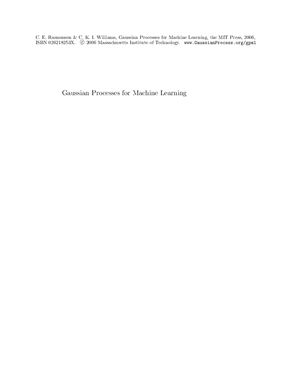Издательство MIT Press, 2006, -266 pp.
The book is primarily intended for graduate students and researchers in machine leaing at departments of Computer Science, Statistics and Applied Mathematics. As prerequisites we require a good basic grounding in calculus, linear algebra and probability theory as would be obtained by graduates in numerate disciplines such as electrical engineering, physics and computer science. For preparation in calculus and linear algebra any good university-level textbook on mathematics for physics or engineering such as Arfken [1985] would be fine. For probability theory some familiarity with multivariate distributions (especially the Gaussian) and conditional probability is required. Some background mathematical material is also provided in Appendix A.
The main focus of the book is to present clearly and concisely an overview of the main ideas of Gaussian processes in a machine leaing context. We have also covered a wide range of connections to existing models in the literature, and cover approximate inference for faster practical algorithms. We have presented detailed algorithms for many methods to aid the practitioner. Software implementations are available from the website for the book, see Appendix C. We have also included a small set of exercises in each chapter; we hope these will help in gaining a deeper understanding of the material.
In order limit the size of the volume, we have had to omit some topics, such as, for example, Markov chain Monte Carlo methods for inference. One of the most difficult things to decide when writing a book is what sections not to write. Within sections, we have often chosen to describe one algorithm in particular in depth, and mention related work only in passing. Although this causes the omission of some material, we feel it is the best approach for a monograph, and hope that the reader will gain a general understanding so as to be able to push further into the growing literature of GP models.
The book has a natural split into two parts, with the chapters up to and including chapter 5 covering core material, and the remaining sections covering the connections to other methods, fast approximations, and more specialized properties. Some sections are marked by an asterisk. These sections may be omitted on a first reading, and are not pre-requisites for later (un-starred) material.
Introduction
Regression
Classification
Covariance Functions
Model Selection and Adaptation of Hyperparameters
Relationships between GPs and Other Models
Theoretical Perspectives
Approximation Methods for Large Datasets
Further Issues and Conclusions
A Mathematical Background
B Gaussian Markov Processes
C Datasets and Code
The book is primarily intended for graduate students and researchers in machine leaing at departments of Computer Science, Statistics and Applied Mathematics. As prerequisites we require a good basic grounding in calculus, linear algebra and probability theory as would be obtained by graduates in numerate disciplines such as electrical engineering, physics and computer science. For preparation in calculus and linear algebra any good university-level textbook on mathematics for physics or engineering such as Arfken [1985] would be fine. For probability theory some familiarity with multivariate distributions (especially the Gaussian) and conditional probability is required. Some background mathematical material is also provided in Appendix A.
The main focus of the book is to present clearly and concisely an overview of the main ideas of Gaussian processes in a machine leaing context. We have also covered a wide range of connections to existing models in the literature, and cover approximate inference for faster practical algorithms. We have presented detailed algorithms for many methods to aid the practitioner. Software implementations are available from the website for the book, see Appendix C. We have also included a small set of exercises in each chapter; we hope these will help in gaining a deeper understanding of the material.
In order limit the size of the volume, we have had to omit some topics, such as, for example, Markov chain Monte Carlo methods for inference. One of the most difficult things to decide when writing a book is what sections not to write. Within sections, we have often chosen to describe one algorithm in particular in depth, and mention related work only in passing. Although this causes the omission of some material, we feel it is the best approach for a monograph, and hope that the reader will gain a general understanding so as to be able to push further into the growing literature of GP models.
The book has a natural split into two parts, with the chapters up to and including chapter 5 covering core material, and the remaining sections covering the connections to other methods, fast approximations, and more specialized properties. Some sections are marked by an asterisk. These sections may be omitted on a first reading, and are not pre-requisites for later (un-starred) material.
Introduction
Regression
Classification
Covariance Functions
Model Selection and Adaptation of Hyperparameters
Relationships between GPs and Other Models
Theoretical Perspectives
Approximation Methods for Large Datasets
Further Issues and Conclusions
A Mathematical Background
B Gaussian Markov Processes
C Datasets and Code

